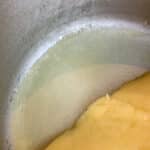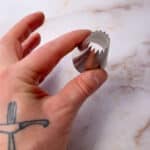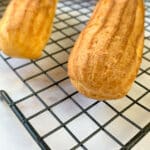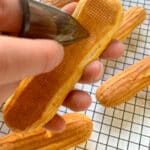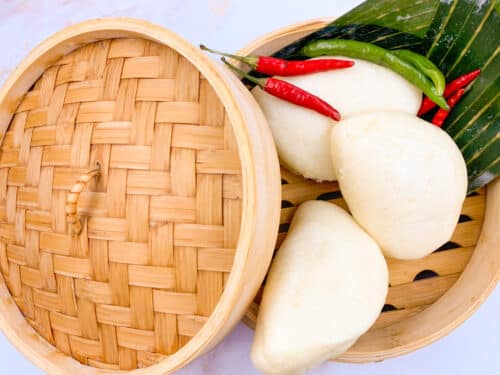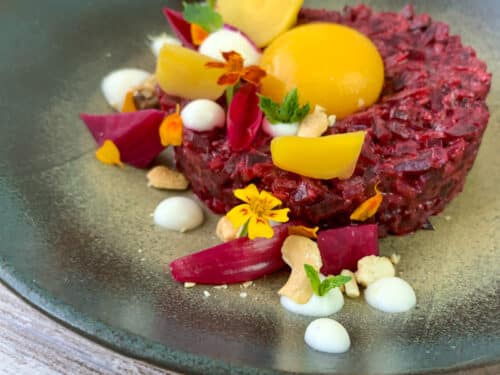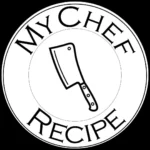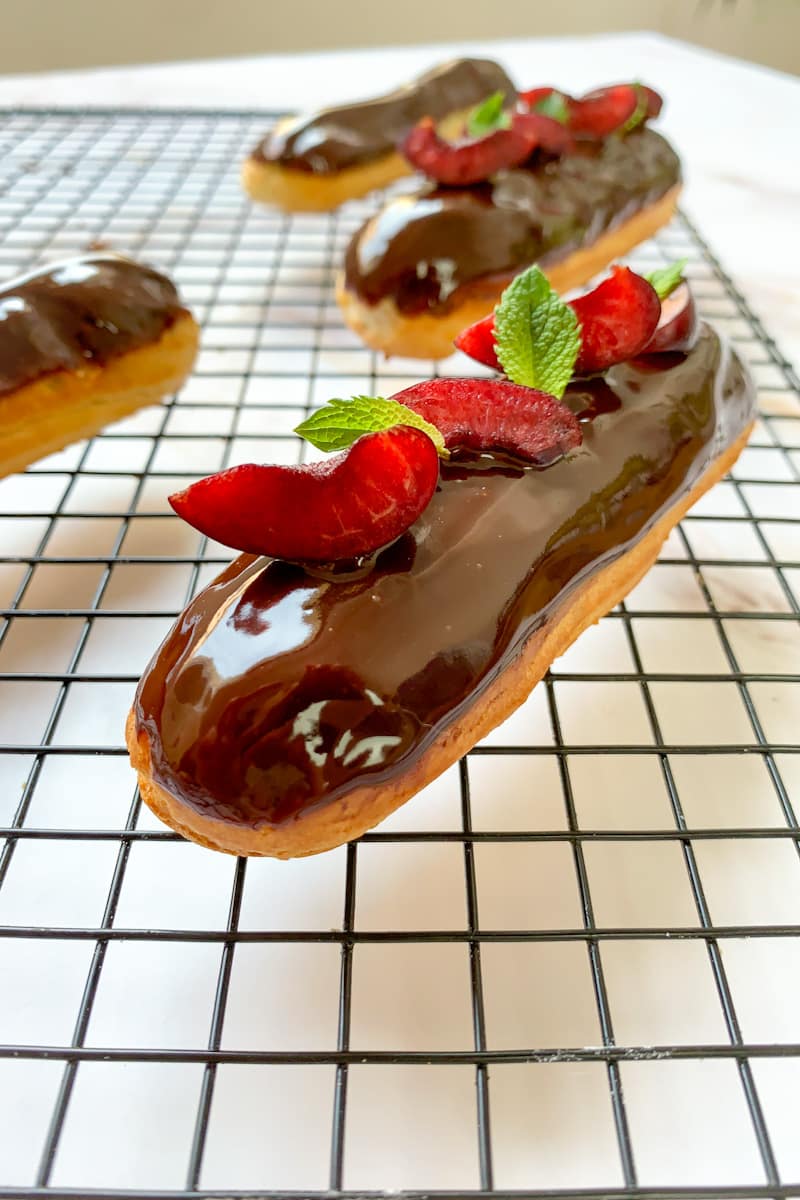
About Éclair
As one of the classics from French pastry, Éclairs are known around the world and served in different versions and flavors. A Éclair is a small, log-shaped bun made from Choux pastry, filled with cream, and coated with a frosting (icing).
Choux pastry which is also used for Profiteroles or savory Gougères becomes firm and crisp when baked, and provides a perfect container for cream fillings. Therefore, the fascination about this pastry doesn’t only come from its flavors, but also its contrasting textures.
Nowadays usually as a cream filling is used pastry cream or chiboust cream (pastry cream with lightened with Italian meringue). The cream is usually chocolate or coffee, but can also be flavored with pistachio or vanilla. Variants can also flavor the pastry cream and the fondant with various fruits.

Éclairs History & Origin
The word “l’éclair” means lightning or thunderbolt in French. Food historians speculate that the pastry gained its name because it shines and flashes when coated with the frosting. Other people propose that they got this name because they are so popular that they disappear as quickly as lightning.
Choux pastry is prepared in a very distinctive way and was apparently invented in the 16th century, at the time of Catherine de Medicis, but a little bit more about Choux pastry and its history later.
At this time a pastry made from choux dough that has been stretched to look like a finger was called “pain à la duchesse”.
It was the famous French cook Antonin Carême (1784–1833) who is attributed to have made the first modern form of Éclair. He filled the pastry with custard and fruit jam, before icing it with melted sugar. This is how the Éclair found its final form as we know it nowadays.
I want to tell you a little bit more about Marie-Antoine (or Antonine) Carême, who is said to be the precursor of French “haute cuisine” and a really fascinating historical figure and the first celebrity chef in history.
He wrote several books about cookery and kitchen culture is responsible for the classification of all sauces into groups based on four mother sauces. Carême is also credited with the creation of the classic chef’s hat, the toque.
Carême was born in Paris in 1784, to a large and poor family. He died just 49 years later in 1833, having spent nearly 40 years of his life working in professional kitchens.
At 10 years of age, his parents sent him away because they couldn’t take care of him and Marie-Antoine started to work in a small tavern as a dishwasher and runner.
When he was 16 years, Carême got a job at a pâtisserie near the Palais-Royal owned by Sylvain Bailly, a famous pâtissier at the time, who recognized his talent and taught him to read and write.
He was one of the first famous kitchen chefs and during his life worked for famous people of the high society, like Napoleon, George IV, Tsar Alexander I, or Rothschild.
Carême wrote “To live well, one must dine well. When we no longer have good cooking in the world, we will have no literature, nor high and sharp intelligence, nor friendly gatherings, nor social harmony.”
If you like classic French pastry, try my Recipe for Creme Brulee with Lemongrass
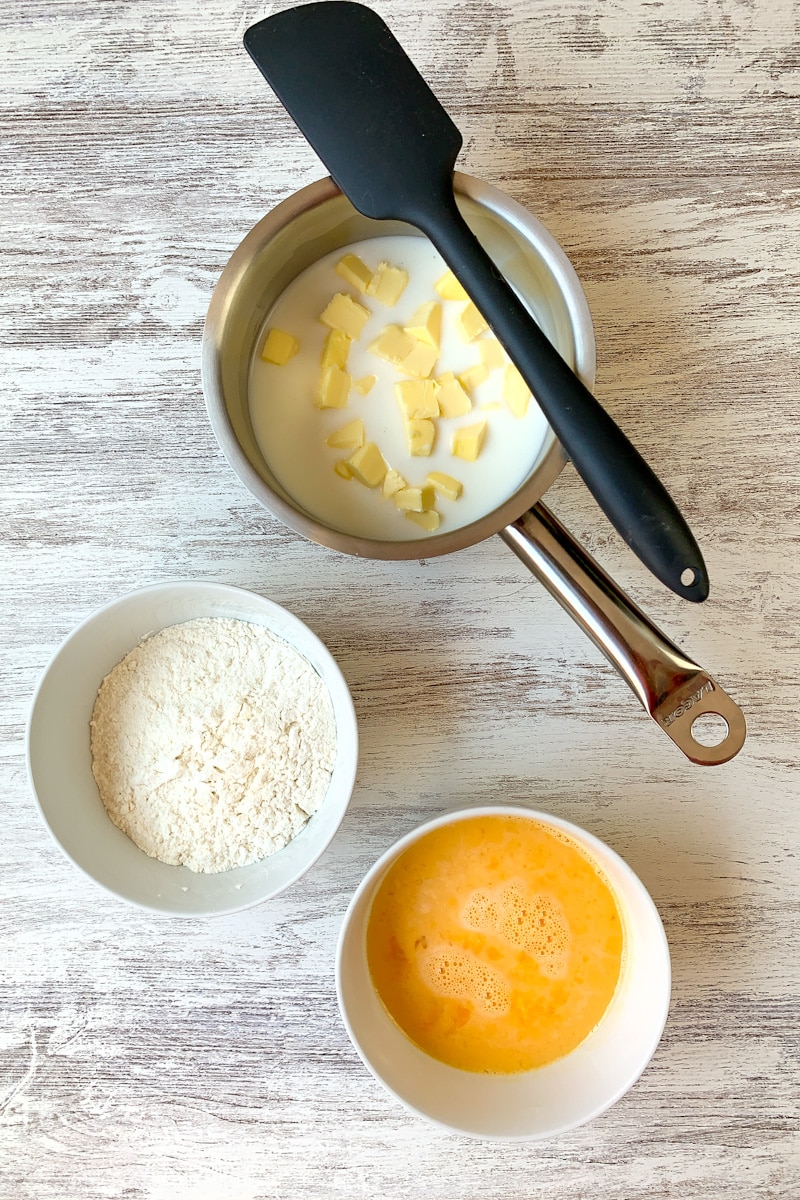
About Choux Pastry
To understand everything about Éclair, one must understand Choux pastry. “Choux” is the French word for “cabbage,” and probably called like this, because the Choux pastry forms little irregular cabbage-like balls. It is a cross between a batter and a dough and is cooked twice.
Because it gets crisp and firm outside and hollow inside, this type of pastry is the perfect vessel for cream fillings.
Choux pastry is made by heating a large amount of liquid (milk and water or only water) with sugar, salt, and butter to a boil. After that, combining the flour to incorporate it, allowing it to cool a little, then adding eggs.
This pastry rises only from the action of steam. It doesn’t need any rising agent like yeast, or baking powder.
One of the theories is, that this pastry was created around 1540 at the court of Catherine de Medicis. How it was fashion, she invited painters, poets, musicians and great cooks. One of the cooks who followed the invitations is a so called Popelini (if he really existed is not completely clear).
It is said that Popelini served a pastry called “pâte à popelin”, small cakes made out of a dough that was similar to a Choux dough.
It was then Marie-Antoine Carême, who changed the dough and modified it, the way we use Choux dough today for a variety of pastries.

Important Facts and tips to master the technique of Choux pastry.
The technique of Choux pastry to make Éclairs is an ingenious invention. Basically, Choux pastry is a mixture of batter and dough and is cooked twice.
The rich and moist paste can be shaped in different forms and cooked into hollow, crisp vessels for creams or other fillings.
When cooking the flour with water, it tenderizes the gluten proteins, preventing them from developing elasticity, and it swells and gelates the starch to turn what would usually be a batter into a dough. When adding the raw eggs, the egg yolks contribute with their richness and high-fat content, while the proteins of the egg whites help to build up more structure, so to create a stable air pocket inside.
- So that the Éclairs have a nice rise, it is essential to use bread flour or flour with a high protein content (At least 12% of gluten).
- It is important to sift the flour before adding it to the mixture, to avoid lumps. Do not pass this step. Also, when adding the flour to the liquid, add it in one go and mix using a spatula.
- Cooking the flour and the liquid for the Choux dough in a pot can take from 3-5 min. When you stick a spoon inside the dough, it should stay upright. It can be that thin skin forms on the bottom of the saucepan. (Do not scrape of this skin from the bottom.) If you want to be exact, you can measure the temperature with a thermometer. The dough should be from 75 °C to 80 °C (in the middle of the dough, not at the bottom of the pan).
- Dry the dough well before adding the eggs. When the mixture is smooth, and a uniform thin film catches on the bottom, the pastry is dry enough to add the eggs. Add the egg when the mixture is still warm.
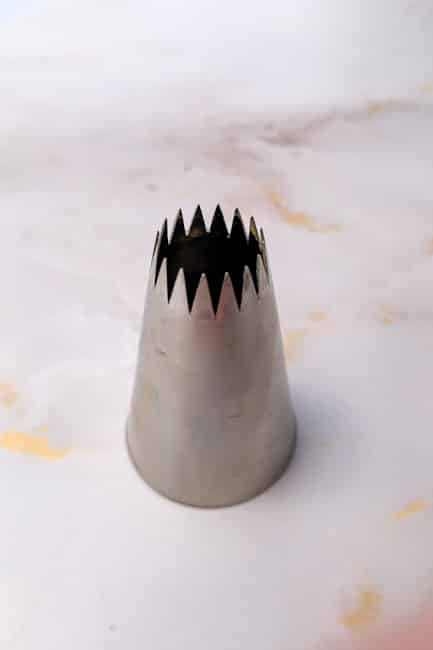
French Star Tip

Perforated silicon air baking mat

Piping in 45 º Angle
Some tips for making the perfect Éclair
When you made your Choux dough, it is time to pipe your Éclairs and bake them in the oven. Here some tips and tricks for this part of the process.
- I think it is best to use a French star tip for pipping. In my experience, the Éclairs get neater, more evenly and no big cracks on the side.
- The proper pipping technique takes some time to be perfect, and it is simply a matter of practice, but there are some tips to consider. Hold the piping bag at a 45º angle and apply steady pressure at such consistent speed as possible. When coming to the end of the Éclair, slightly twist your piping bag to cut the end. It doesn’t matter if the endings are not perfect. With a damp finger, pat down those pointed ends.
- To bake the Éclairs, use a perforated silicon air baking mat for the best outcome. Like this, the air can circulate better when baking. You can also use normal parchment paper. Do not use a normal silicon baking mat, because the Choux pastry tends to get moist and soggy on it.
- After making the Choux dough, let it rest in the refrigerator for at least one hour, up to three hours before using. This way the gluten can relax, and the dough is better to work with, which will help create more even and crack-free Éclairs.
- To bake your Éclairs perfectly, preheat the oven to 180 °C (356 °F). Bake the Éclairs without ventilation, so as not to blow out the steam.
- Depending a little on your oven, the Éclairs takes about 40 minutes to bake. Do not open the door of the oven in the first 30 minutes or the Éclairs will deflate. After this first 30 minutes, shortly open the oven to release the built-up steam and cook for the remaining time until golden brown.
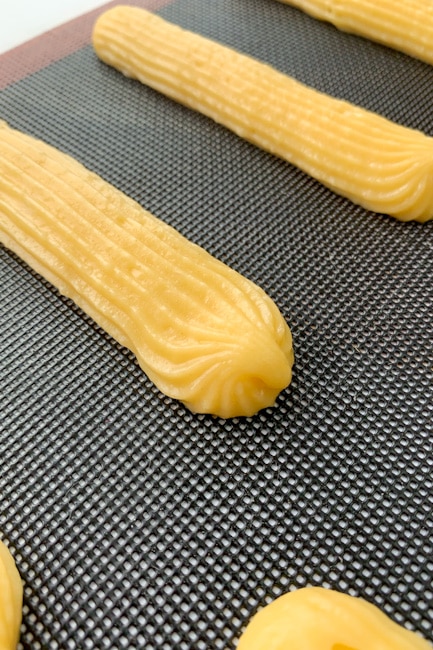
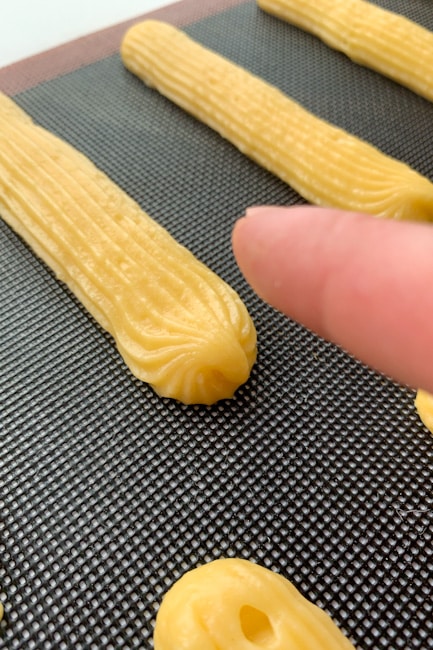

When you reach the end of the Éclair, slightly rotate the pastry bag to cut the end. It doesn’t matter if the endings aren’t perfect. With a damp finger, tap the pointed tips.
Why a honey chocolate glazing?
To make a chocolate glazing, which stays shiny and retains its softness, you normally have to use invert sugar, which is inverted (split) sucrose and has the property of capturing the water in the mixture of chocolate.
But invert sugar is not easy to buy, and I like to try different approaches to recipes. If you substitute invert sugar for honey you can reach a similar outcome.
Honey can play the same role as invert sugar, due to its composition. It is not only a natural sweetener but also has amazing chemical properties. Honey is a mixture of sugars that capture more water than a single sugar (normal sugar).

Frequently asked Questions about Éclairs and Troubleshooting
Why Éclairs crack?
This can have various reasons. Try using a French star tip for piping instead of a plain nozzle. This makes a big difference, as the small ridges help to expand the dough more evenly. Also maybe your oven temperature is too high (maybe your oven is not accurate, dry a thermometer).
Why Éclairs deflate?
If your Éclairs deflate, when you take them out of your oven, they definitely have not been baked long enough.
Why are my Éclairs flat?
Your Éclairs did not expand enough in the oven because the oven temperature was not hot enough, or your dough is too wet (try using less liquid).
Where to store Éclairs?
If the Éclairs are not filled, yet you can store them in an airtight container at room temperature. If your Éclairs are filled already, you should eat them in 36 hours before they get soggy. (that should not be too difficult)
Can Éclair shells be frozen?
Although they will never be as perfect as fresh ones, you can freeze the Éclair shells without the filling or the topping for up to three months.
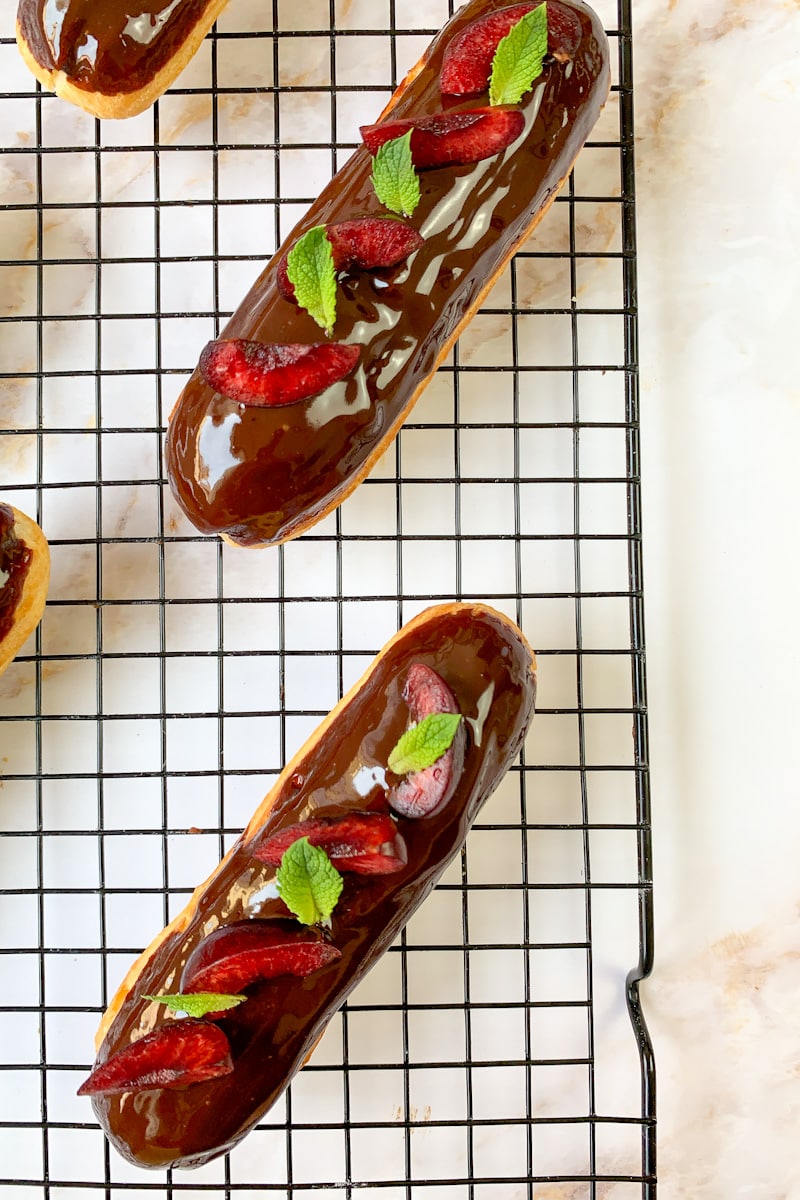
Perfect Classic Chocolate Éclair Recipe
Equipment
- kitchen scale
- fine sieve
- pot
- rubber spatula or wooden spoon
- whisk
- piping bag
- french star nozzle tip (if you don't have one, use a plain tip)
- perforated silicon air baking mat (if you don't have one, use parchment paper)
Ingredients
For the Choux dough
- 100 g milk
- 80 g water
- 80 g butter cut in small cubes to melt quicker
- 3 g salt approx. 1/2 teaspoon
- 5 g sugar approx. 1 teaspoon
- 100 g flour bread flour or high protein content flour
- 150 g whole egg more or less 4 eggs
- some icing sugar (confectioners' sugar) for powdering
For the pastry cream with chocolate
- 500 g milk
- 100 g sugar
- 80 g eggyolk 4-5 eggyolks
- 50 g corn starch
- 50 g butter
- 100 g dark chocolate
For the icing
- 150 g dark chocolate
- 100 g cream
- 40 g honey
Instructions
For the pastry cream with chocolate
- In a bowl whisk together the egg yolks and the sugar. Add the cornflour and mix well until incorporated.
- Pour the milk into a saucepan and bring to a boil. (If you want to make a vanilla pastry cream, you can add the cut or scraped vanilla bean to the milk).
- When the milk is boiling, slowly add 1/4 of the milk to the mixture of yolks, while constantly stirring with the whisk. Then gradually add the rest of the liquid. Mix all ingredients well.
- Return everything to the saucepan and heat rapidly while whisking energetically.
- When the mixture thickens, continue to whisk. From the time it starts to boil, count 90 seconds per 500g of milk.
- Remove from the heat, add the butter and the chocolate and mix until combined. (when you want to make a vanilla pastry cream, leave out the chocolate)
- Pour into a baking tin or a bowl to cool and cover with plastic wrap, with the plastic touching the surface of the cream. Always whip the cream vigorously before using, to smooth it out.
For the Choux dough and the Éclair shells
- Weigh the flour and sift it with a fine sieve to eliminate lumps. Set aside.
- Put the milk, water, sugar, salt and butter in cubes in a saucepan. Over medium heat, bring the mixture to a boil. Take care that the butter melts before the milk comes to a boil.
- When the mixture begins to boil and the liquid starts to rise, remove the saucepan from the heat, then pour in the flour in one go and mix using a spatula (or wooden spoon). Mix everything well until it forms a smooth ball and no more flour bits are visible.
- Place the saucepan back to the stove and cook the dough for 3-5 min over medium heat mixing constantly. It can be that thin skin forms on the bottom of the saucepan. (Do not scrape of this skin from the bottom.) If you want to be exact, you can measure the temperature with a thermometer. The dough should be from 75 °C to 80 °C (in the middle of the dough, not at the bottom of the pan)
- Remove from the heat, transform the dough to a bowl and let cool down slightly. Meanwhile, weigh the eggs in a separate bowl and slightly beat them with a fork, to mix the yolk with the whites.
- Only add a small amount of egg at a time and mix well. When it is completely incorporated, add more, until everything is incorporated and the dough is smooth and shiny.
- Transfer the dough into a piping bag with a French star nozzle tip (if you don't have one, use a normal round tip) and let the dough rest into the fridge for at least one hour, until three hours before piping.
- Preheat the oven to 180 °C (356 °F).
- Use a perforated air silicon mat, if you don't have one, use normal parchment paper. (when you use parchment paper, put a bit of dough under the edges of the paper, so it does not slide while piping)
- To make them all the same size you can use a spatula or something about 12-15 cm long to orientate yourself. Leave enough space between the Éclairs, as they puff up in the oven. Use the piping bag in a 45º angle and pipe with consistent speed and pressure. When coming to the end of the Éclair, slightly twist your piping bag to cut the end. It doesn't matter if the endings are not perfect. With a damp finger, pat down those pointed ends.
- Sprinkle the piped Éclairs with confectioners' sugar.
- Place the baking tray in the middle rack of your oven. Bake for 30 minutes and do not open the door. After 30 minutes the Éclairs should be golden brown and nicely puffed up. Open the oven door quickly to release the steam and bake for another 10 minutes.
- Let them cool either on the perforated air mat or if baked on parchment paper then let them cool on a cooling rack.
For the icing
- Melt the chocolate over a water bath or in the microwave until liquid.
- In a saucepan add the cream and the honey and bring to a boil.
- When the mixture starts boiling, pull away from the heat and add the melted chocolate. Mix everything well until incorporated.
How to fill and glaze the Éclairs
- When the Éclairs have cooled down, with the point of a knife or a small pastry bag nozzle tip make three small holes in the bottom of the Éclair.
- Put the chocolate pastry cream into a pastry bag with a small nozzle tip and fill the Éclairs with the pastry cream through the holes you made at the bottom of the Éclairs. When they are filled, they should be quite heavy.
- To glaze the filled Éclairs, the icing should be warm and in a liquid state (if not heat up again). Pour the icing in a container or bowl, big enough to tip in your Éclairs in full length.
- Secure the Éclair on the bottom and tip the top side into the chocolate. Let the chocolate cool down.






